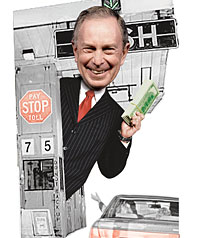
1. CONGESTION PRICING IS A TROJAN HORSE
Mayor Bloomberg’s Earth Day speech compiled 127 ideas for making the city more “sustainable” by 2030. But congestion pricing has dominated the conversation ever since. Which may be just what the mayor needs to get the rest of PlaNYC going.
Bloomberg’s aides debated nearly to the end about whether to include CP in PlaNYC, partly because it was sure to provoke headlines about angry drivers. But endorsing congestion pricing, besides being good policy, came with a crucial political upside: It won Bloomberg the support of editorial pages and of energetic transportation activists. “We’ll mobilize teams of organizers to go into battleground state-legislator districts,” says Paul Steely White, the head of Transportation Alternatives. City Hall supplied a list of potential collaborators, from unions to ministers, and the day after Bloomberg’s big speech, the “Campaign for New York’s Future” made its debut.
The furor over congestion pricing is also usefully obscuring. “State legislators who are against congestion pricing will want to show they’re not against all environmental programs,” says Bill Cunningham, the former Bloomberg political strategist who’s now at Dan Klores PR. “So they’ll get onboard with the mayor’s mass-transit ideas.”
Bloomberg disdains empty rhetoric. When he’s made a big show of taking on tough issues in the past—the public-school system, illegal guns—he’s backed up the words with sustained action. Last week, the mayor added $150 million to the city budget to launch his 2030 initiatives. Yet he’s deferring some relatively easy fixes—like pushing harder to “green” the building code. And the sketchiness of when and how he intends to deliver on the grandest ideas feeds suspicions that PlaNYC is a green fig leaf for boosting real-estate development.
The 2030 plan evokes a sense of déjà vu, from the prominent role played by Deputy Mayor Dan Doctoroff to the look of the glossy 156-page PlaNYC brochure (produced by the same design firm that did the city’s 2012 Olympics propaganda). The city is better off for having lost the Olympics—we’ll probably get a 7-train extension without the billion-dollar boondoggle West Side stadium. And development is booming in the neighborhood. This time, the central goal—a radically greener, more self-sustaining city—is both worthier and more diffuse. Bloomberg has created a profoundly hopeful moment in the environmental life of the city. It would be truly depressing if the primary result of the Olympics bid and PlaNYC turns out to be the same: lots of big new buildings, only this time with Bloomberg’s million new trees growing in the shadows.
2. THAT’S A WHOLE LOT OF TREES
The most immediately persuasive— and apparently easy-to-envisage—part of Mayor Bloomberg’s PlaNYC is the initiative to plant 1 million trees. Who doesn’t love trees? Deputy Mayor Dan Doctoroff called it “the most ambitious tree-planting program ever undertaken, certainly by any American city.” It easily out-reforests Chicago, where Mayor Richard M. Daley has won awards for planting fewer than half that number. But is it even possible? Planted at the standard 350 per acre, our new trees would blanket 3.4 Central Parks. If you planted the trees 25 feet apart on both sides of a street, your lane would be shaded for 2,367 miles—from here to Salt Lake City. It’s also 69 percent more trees than the 592,130 now planted on city streets. The city plants 8,000 trees a year, mostly to replace dead ones; Bloomberg’s plan installs 23,000 annually for ten years. What about the other three-quarters of a million? Some will go to reforesting parks. But “to hit 1 million trees, we can’t do that just on public property,” admits Parks Commissioner Adrian Benepe. “We could probably get about halfway there; the rest has to happen in other people’s initiative.” Institutions, backyards, and nonprofits will need to pick up the slack.
—Carol Vinzant
3. THE BQE IS HARD TO BUILD ON
Tucked into the mayor’s megaplan was a seemingly bold idea: Put a big lid on the sunken swath of the Brooklyn-Queens Expressway that divides Carroll Gardens and Cobble Hill from the waterfront—and build housing over it. The plan, however, elicited jaded yawns from locals, who call it the Trench. Frank Manzione, who has a real-estate agency near the highway, says he’s heard “all the grandioso plans” to cover it over the decades. What’s new this time? A source at City Hall who declined to be named said that although no financing or developers are involved yet, it would incorporate high-tech towers to vent exhaust high over rooftops, avoiding the unpleasant, unusable terraces of the Bridge Apartments, which were built atop the fume-spewing highway leading to the George Washington Bridge in 1961. “I think it would be a great thing,” drawls Harry Hawk, who lives on Hicks Street and cooks the burgers at Schnäck, around the corner. “But it’s like saying, ‘I’m going to marry you someday, honey.’ No one believes it’s going to happen.”
—Tim Murphy
Have good intel? Send tips to intel@nymag.com.